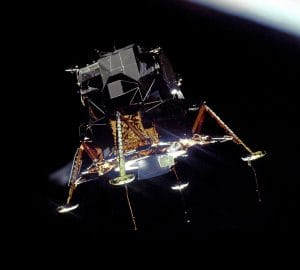Garman was one of the around 10,000 engineers hired by NASA as the space agency worked to achieve President John F. Kennedy’s “goal, before this decade is out, of landing a man on the moon and returning him safely to the Earth.” Garman wanted to work with computers, and was assigned to the Apollo Guidance Program Section. On July 20, 1969, moments before mankind’s first attempted landing on the moon, Neil Armstrong called in a problem: an alarm code flashed by Eagle’s crude computer. “Program alarm,” Armstrong, radioed. “It’s a 1202.” Few at Mission Control had any idea what “1202” meant, but everyone was aware that the spacecraft was running critically low on fuel. “When I heard Neil say 1202 for the first time,” said astronaut Charlie Duke, who was CAPCOM (the Capsule Communicator, talking to the crew), “I tell you, my heart hit the floor.” Even the Guidance Officer, Steve Bales, didn’t know if “1202” was a real problem on not, so he quickly asked Garman, then 24 years old, what to do. That put Garman on the spot: if the error could be safely ignored, the mission might succeed. If it couldn’t, the mission had to be aborted. The safe thing would be to abort, at the cost of failing to achieve the goal and disappointing a huge percentage of humanity, watching the landing attempt live. If Garman was wrong, everyone watching might instead witness the astronauts’ deaths in real time. Garman had only a second or two to decide. “I said,” he remembered later, “As long as it doesn’t reoccur, it’s fine.” Garman’s reputation and career were at stake: he would either be a hero, or a scapegoat — there was little room anywhere in between. But he had studied every aspect of the software’s operation, even going so far as purposefully triggering “fatal” errors in simulations, and was confident in his answer.

Yet Armstrong called in more errors. Each time, controllers went straight to Garman. “I remember distinctly yelling — by this time yelling, you know, in the [voice communications] loop here — ‘Same type!’” Garman said. “I licked my dry lips. This was a time for discipline,” said Eagle’s lunar module pilot, astronaut Buzz Aldrin. “But the tension had me rigid in my suit. We had to trust Mission Control.” He told Armstrong: “We’re go. Same type. We’re go.” Then the radio went silent, and everyone in Mission Control — and the world — waited to hear what happened. Moments later, Armstrong radioed home, “Houston, Tranquillity Base here. The Eagle has landed.” The spacecraft had only about 25 seconds of fuel left. The alarms meant the computer was overloaded, but Armstrong, who had practiced the landing many times in a simulator, adjusted attitude slightly to reduce the load on the computer, and was able to land successfully. Later in his career, Garman was part of the team which figured out how to get the Apollo 13 crew back alive after a critical accident on the way to the moon. For that, the team was awarded the Presidential Medal of Freedom. Garman rose to Deputy Director of Mission Support, and Chief Information Officer, for the Johnson Space Center, before leaving NASA in 2000 to work in private aerospace industry. “You don’t realize until years later, actually, how doing the wrong thing at the right time could have changed history,” he said. Garman, who still lived in the Houston area, died September 20, from bone marrow cancer. He was 72.
